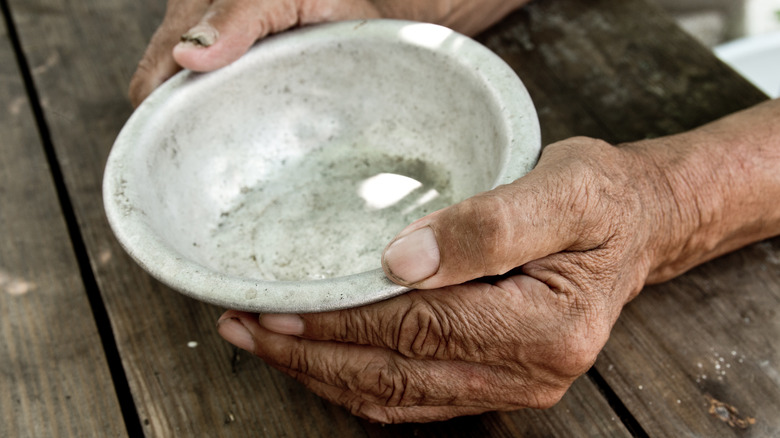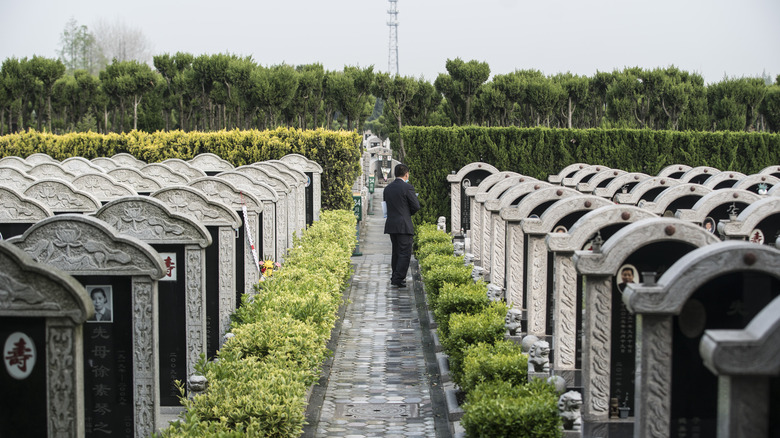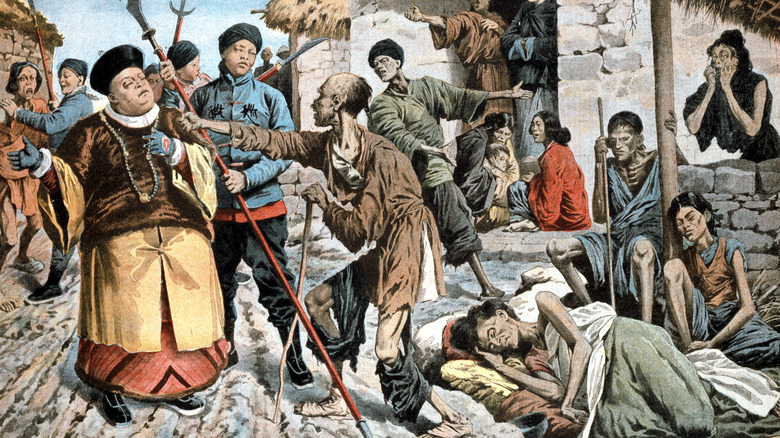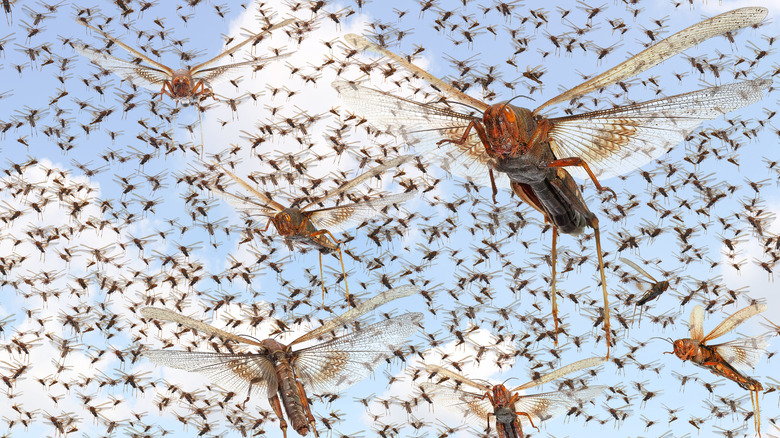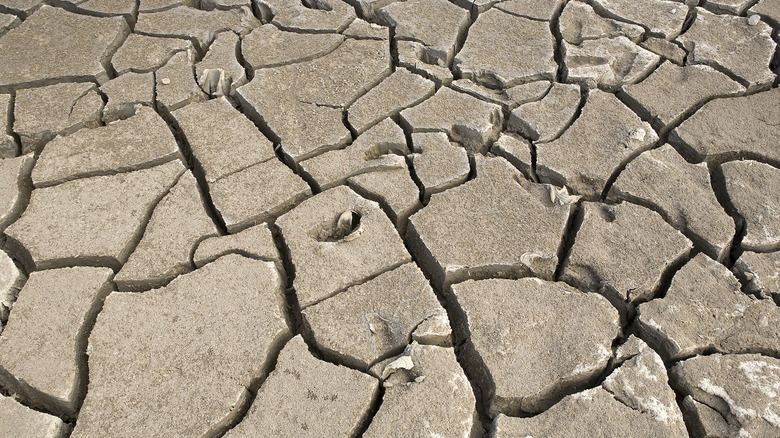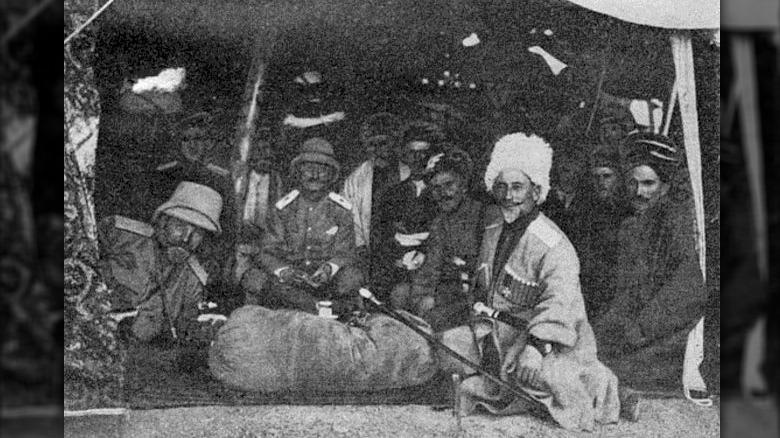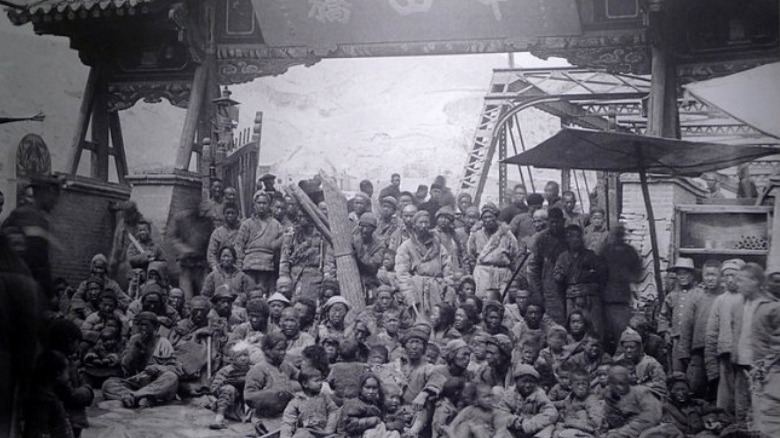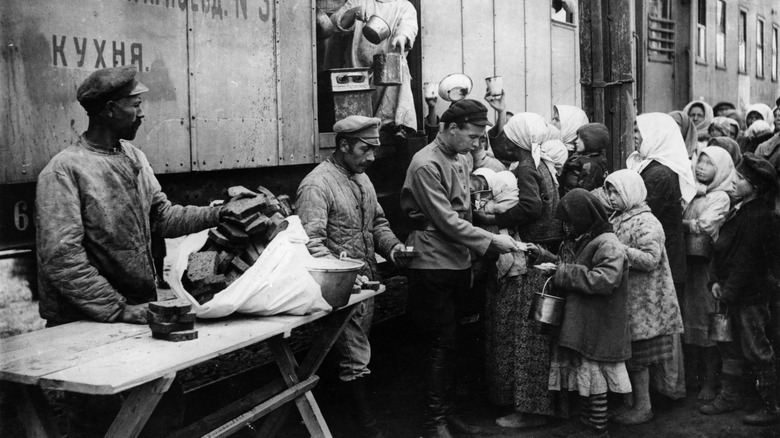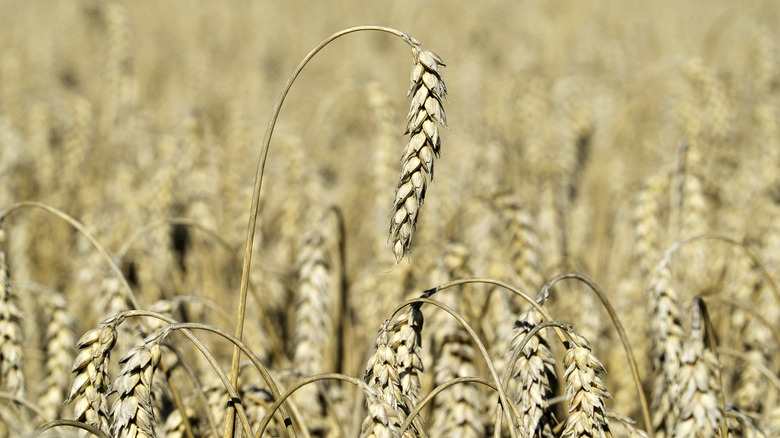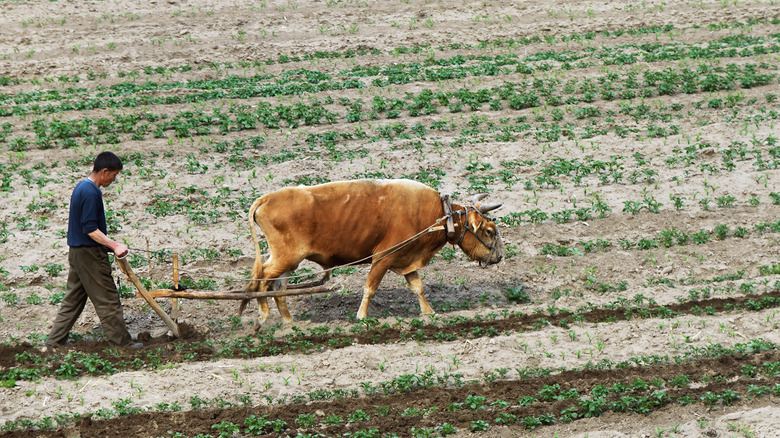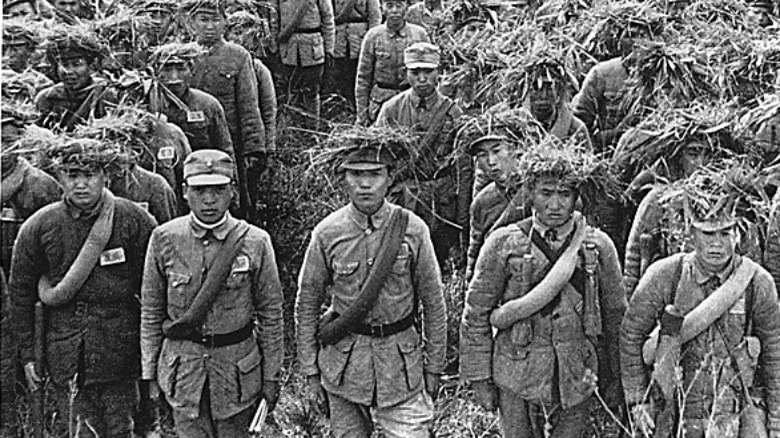The Biggest Famines In World History
It's tempting to think the modern world is a place where starvation doesn't happen anymore. A little of that is delusion (that guy with the cardboard sign isn't really hungry, he just wants beer!) and a little of that is just wishful thinking. But the truth is, the world is a bad, bad place, evil people do evil things, and sometimes the weather is just as evil as the people are.
Famines have been a thing since the beginning of human history, and nothing's really changed since the notorious Urgh vs. Urm wars of 2 million B.C., when Urgh stole all of Urm's figs and Urm burned down Urgh's apple tree. Just kidding, that never happened. Still, famine has human causes as often as it has environmental causes, and as the world's population has grown things haven't really gotten any better. A startlingly large number of the world's worst famines happened in recent history, many of them in the good ole 20th century, a time that a lot of people can actually remember. So let's take a walk through the history of world famine, and maybe make a note that we should try not to repeat the things that caused past famines. Just a thought.
The Great Chinese Famine (1959-1961)
The Great Chinese Famine was the worst in human history, and yet it was so recent that there are people living today who can remember it happening. According to BMJ, the famine began in 1959 and continued into 1961. It was not caused by drought or a plant virus that wiped out crops or anything similar; it was caused by the ironically named "Great Leap Forward," the brainchild of Mao Zedong, founder and chairman of the People's Republic of China. The Great Leap Forward was supposed to result in light-speed advances in technology and prosperity, but all it did was kill millions of people and prove to the globe that some world leaders have no idea what they're doing.
In order to make China the economic power he envisioned, Chairman Mao decided that millions of farmers would have to become miners. To make up for the fact that these peasants would no longer be working in the fields, Mao established agriculture communes, which turned out to be not very efficient at growing and distributing food.
This plan was stupid for a lot of reasons, but the switch from farming to mining didn't even result in a productive steel industry. Instead, the inexperienced miners tried smelting metal in clay furnaces and produced mostly worthless hunks of low-quality metal. Meanwhile, people in a third of China's provinces faced food shortages, and by 1961 around 30 million people had starved to death.
The Chinese Famine of 1907
According to the "Encyclopedia of Disaster Relief," the Chinese Famine of 1907 was the second-worst famine in history, coming close to the Great Chinese Famine that began more than half a century later. It happened before communism and the Great Leap Forward, during the Qing Dynasty, but unlike the famine of 1959, it was largely caused by environmental disaster. Before heavy rains and flooding during the growing season in 1906 wiped out crops over 40,000 square miles in the Anhui, Honan, and Kiang-Su provinces, Chinese farmers were learning to grow imported crops like corn and sweet potatoes, and using new techniques such as terraced farming, better irrigation, and grain storage. That wasn't enough to stop the famine, though, and by the beginning of 1907 about four million people were starving. Food riots broke out all over the country, and starving people congregated in overcrowded refugee camps, where diseases like smallpox ran wild and killed even more people.
The 1907 famine didn't end overnight, but media attention helped slow it down as people all over the world donated food and money. Ultimately, the famine killed an estimated 25 million people and also contributed to the fall of the Qing Dynasty, not because the Qing Dynasty caused the famine but because of its abject failure to manage the disaster.
The Great North China Famine (1876-1879)
Prior to the devastating famines China experienced in the 20th century, Northern China suffered a major famine under the watch of the Qing Dynasty, during the late 1870s. According to Cambridge University Press, this famine was also sparked by environmental conditions, but exacerbated by Qing Dynasty policies. In the years just before the famine, there were a number of significant events including drought in some places, excess rain in others, flooding, warfare, disease, plagues of locusts and rats, even wolf attacks. What's more, the government didn't really seem very interested in doing anything to help the suffering people — there was some relief offered to people in a few limited places, but not enough to really make a difference.
Cambridge University Press says it's hard to pinpoint the precise cause of this particular famine, especially since 19th-century China was marked by other famines. Much of what historians know comes from local records, which talk about a "great drought" that caused crops to fail and forced some people into eating bark, grass, and even "weathered rocks." Other records discuss inflated food prices, dry lakes, and cannibalism. Still others discuss government relief that provided very little help and dried up after just six months. Overall, the disaster seems to have been confined to a large number of small, localized areas, and was made worse by the lack of assistance from the government. Overall, death toll estimates number between 9 and 13 million people.
The Skull Famine (1788-1794)
An 18th-century Indian famine is ominously known as "the Skull Famine," which doesn't really make it any worse than any other famine, but does give it rather sinister overtones. According to the Medieval History Journal this 1791 famine was so-named because, at its worst, victims were left unburied, and their skulls littered the ground.
During 1788-1794, famines affected most of India, caused by a series of alternating droughts and severe El Niño events, conditions that may have persisted for up to eight years. By 1792, 600,000 people had died in 167 districts in India. The deaths were largely attributed to drought, but short periods of violent rainfall were also noted. In October of 1791, for example, 25.5 inches of rain fell in just three days. Conditions were so bad that in some provinces up to a third of the villages were abandoned.
There's no doubt that the years of drought and flood were the root cause of the famine, but this was during British colonialism, and the suffering was exacerbated by the fact that the colonizers weren't doing much to try and offset the fact that rice crops were failing all over the country. By the time the famine was over, around 11 million people in India were dead. The consequences went farther than that, though — the Medieval History Journal also notes that the effects of the severe weather events were felt as far away as Australia, Europe, and Mexico.
The Bengali Famine of 1770
During the 18th century, British colonialism was responsible for more than one famine on the Indian subcontinent. In fact, according to the Medieval History Journal, there were at least 12 different famines during the period between 1765 and 1858 when the British East India Company was in charge. In those days, the prevailing theory amongst the colonists was that famines were good because they kept the population in check — the poor Indian population, that is. It's just a guess, but it is unlikely that many people would have expressed the same sentiment about a famine's effect on wealthier people, like most of the white colonists.
The 1770 famine happened after the failure of the monsoons in 1768 caused the rice fields to dry up. The already dry conditions were made worse by a drought that affected most of Bengal and persisted for at least six months. Contemporary reports say that one third of the population of Purnea province starved to death and many of those who didn't fled to Nepal. Meanwhile, the British government continued to concern itself with wringing as much revenue from the struggling nation as possible, which naturally led to even more suffering and death. By the end of the 1770 famine, 10 million people were dead.
The Persian Famine (1917-1919)
In 1917, the British decided to take over Iran and then proceeded to cause a famine that killed between 8 and 10 million people. According to "The Great Famine & Genocide in Iran: 1917-1919," British forces in Iran started by hoarding food for themselves, but the shenanigans quickly escalated until the British were just deliberately buying up local food stocks and putting it all in storage, leaving the locals with nothing to eat. Records made at the time claim this was being done so the British would be able to feed troops stationed in Iran, Iraq, and Russia, but the Iranians themselves had other theories. Those who hadn't already starved to death believed the British were deliberately causing a famine so they could later swoop in with free food and call themselves saviors.
All of this was made worse by widespread drought and disease, which was impacting harvests and making already scarce food even scarcer (via Atlantic Council). At the famine's height, local newspapers said thousands of people were dying every day, and that unburied corpses filled the streets and alleys of Tehran. Some estimates say the death toll was between 8 to 10 million people, though others more conservatively say it was closer to 2 million (via Tehran Times).
The Northwest China Famine (1928-1930)
Let's head back to China now, which experienced yet another major 20th-century famine between 1928 and 1930. This particular famine affected 300 or so counties in the northwest part of the country and was caused by a combination of factors that included drought and the actions of a bunch of warlords, because never in the history of anywhere has there been such a thing as a warlord that didn't cause problems.
According to Disaster History, in the late 1920s, drought devastated the Wei River Valley, leaving 9.2 million acres of previously fertile lands completely dry. That was a contributing factor, but the bigger problem was the warlords who were running around the place demanding grain and livestock and telling everyone that they had to start farming opium on what little remaining land was actually capable of supporting crops. Meanwhile, the Chinese government was no help at all — the northern provinces were neglected to the point where dams weren't being maintained. Worse, the people were expected to help subsidize the military with supplies they really needed for themselves.
Because governments that contribute to famines within their own borders don't tend to like keeping mortality records, no one is sure how many people died in northern China between 1928 and 1930, but estimates range from 3 to 10 million. At least 6 million people fled the Wei River Valley, and the Famine Relief Commission estimated that up to 4 million were impoverished and begging for food.
The Holodomor (1932-1933)
Communism in the 20th century has been associated with an awfully high mortality rate in China, and the same is true of communism's originating nation, the Soviet Union, though on not quite so big a scale. According to the University of Minnesota, in 1932 — just a couple of years after the famine that devastated northern China — Joseph Stalin decided to deliberately engineer a famine in Ukraine. Called "Holodomor," which is a nice, literal name meaning "death inflicted by starvation," the famine was Stalin's way of telling Ukrainians that they were going to be a part of the Soviet Union, whether they liked it or not.
The Soviet Union annexed most of Ukraine in 1922, but it also enacted policies that helped preserve Ukrainian culture and language. When Stalin came into power, though, he feared all of that cultural autonomy might make Ukraine think too highly of itself, so he had a bunch of people executed and seized control of Ukraine's farms. More than 4 million tons of grain were shipped out of the country, and villages that couldn't meet ridiculously high production quotas were essentially walled off by Soviet troops, who let no one out and nothing in. Unable to flee, people starved to death in their homes. By the time Stalin was done with Ukraine in 1933, somewhere between 3.9 million and 7 million people were dead.
The Russian Famine (1921-1922)
According to the Warwick Modern Records Center, in the early 1920s famine swept across the young Soviet Union, and though human cruelty played a significant role, this famine was no deliberate genocide.
The famine of 1921 to 1922 did not owe its causation to simple circumstances. Instead, a number of different factors came together in a sort of horrifying serendipity, starting with drought and the subsequent failure of a number of important crops. That alone might not have caused so much devastation, but the country was also reeling from its involvement in a series of wars including World War I, the Russian Civil War, and the 1917 Russian Revolution. Wars always have an economic cost, but wars that happen inside a country's borders can have devastating consequences that include damage to civilian property and the destruction of farms and livestock. When the Soviets assumed control of Russia, they also annexed grain and seed from poor farmers, which left the farmers with nothing to eat and nothing to grow. This complex series of events ended up causing widespread famine that killed at least 5 million people.
The Great Famine (1315-1317)
The thing about medieval and renaissance history is that it doesn't always remember exactly the way things happened, and it doesn't usually have all the numbers. That's because historians were largely uninterested in the fate of regular people like farmers and merchants. This is why we know the details of Anne Boleyn's bout with the sweating sickness, but we don't really know how many people died of the black plague.
Similarly, we don't really know how many people died during the Great Famine, which struck Europe between 1315 and 1317. According to historian Lynn Harry Nelson, at the time there were so many people living in Western Europe that, even in good years, it was barely possible to grow enough food to support them. This means that even a small kink in the system could lead to a cascade of events that could spark a famine, and that's exactly what happened in 1315 when heavy rains rotted seed stores and made it harder to get the fields ready for planting. Production dropped, which led to widespread food insecurity. The next growing season was more of the same, and by then the food shortages were being felt everywhere. It got so bad that people abandoned their children and the elderly starved themselves to death so their families could go on. No one is really sure how many lives were lost during the Great Famine, but historians are pretty sure it was "millions."
The Ukraine and Belorussia Famine (1946-1947)
Because Ukraine hadn't already been through enough, in 1946, just 13 years after the Holodomor, a second famine struck the area. This time, it spread as far as Belarus, and its cause was — surprise — Stalin. Well, not directly, but Stalin did nothing to help the Ukrainians and also didn't even try to hide the fact that he was enjoying their suffering, calling it the natural result of "Ukrainian bourgeois nationalism."
The famine of 1946 started when drought struck the southern part of the country. According to GlobalSecurity.org, historians don't know much about this famine because by that point the Soviet disinformation machine had become very, very effective at its job and virtually no information was being shared with the outside world. Historians do know that grain production was down by more than 50% from what was typical for the region. At the same time, a lot of what was produced in rural Ukraine was being shipped off to resource-hungry cities, leaving very little for the people in charge of producing the food. Stalin not only ignored pleas for help, he also accused Ukrainian farmers of being incompetent and responsible for their own problems and sent armed officials to confiscate bread from starving peasants.
Many Ukrainian farmers got help from peasants in western Ukraine, who gave them food in exchange for belongings, thus preventing a bad situation from becoming much worse. Even so, an estimated 3.9 million people died in the 1946 famine.
The North Korean Famine (1994-1998)
According to the Wilson Center, the North Korean famine of the 1990s is poorly understood, just like most of what happens in North Korea. That's because the people in charge of North Korea want the outside world to think communism is awesome and everyone in the country is doing Just Fine. Famines, unfortunately, don't tend to support that narrative.
It's pretty hard to hide an entire famine from the world, though, even if you're North Korea — eventually, word gets out. The North Koreans claimed flooding disrupted the food supply, but the Wilson Center says the famine was largely due to the "Stalinist agriculture system," which basically disincentivizes farming. The government exacerbated the problem by cutting off the food deliveries to parts of the country in order to ensure that everyone in the capital would have enough to eat (sounds a bit "Hunger Games," doesn't it?). Then it cut rations to farmers who (surprise) responded by hoarding food.
The North Korean government admits there was a famine but says 235,000 people died at most. People who know better, though, say the death toll was actually somewhere between 2.5 million and 3.5 million.
The Bengal Famine of 1943
The 1943 Bengal Famine didn't kill as many people as some famines of the time, but the International Journal of Studies in Public Leadership (IJSPL) still calls it "one of the worst man-made famines recorded in human history." Like the famine of 1770, the Bengal Famine of 1943 had roots in colonialism. According to the Guardian, there wasn't even a drought to take part of the blame. In fact, data indicates there was plenty of rainfall during the worst part of the famine, though the Japanese capture of Burma (which supplied rice to parts of India) and a number of crop diseases had caused some minor food shortages.
Mostly, the disaster seems to have stemmed from wartime inflation and panic buying, coupled with government-ordered rationing and elevated taxes (via IJSPL). And because the British were afraid that the Japanese would invade India and confiscate food, they also did messed-up stuff like confiscating massive amounts of rice just to keep it from maybe falling into the hands of the enemy. All of this caused prices to climb even higher, which made food too expensive for the poorest Bengalis. Meanwhile, Winston Churchill was publicly blaming the famine on the people, complaining that Bengalis were "breeding like rabbits" and exaggerating how bad the famine was, you know, because obviously if the famine was so bad then Mahatma Gandhi would have died already. Historians think about 3 million people died during the Bengal Famine of 1943.
The Henan Famine (1942-1943)
War isn't good for much, but it's especially bad for civilians. Famines are frequently associated with wars, even wars as recent as World War II.
According to "The Ecology of War in China," in 1943 China's Henan Province suffered a drought, and the Nationalist regime not only couldn't be bothered to do anything about it (they were preoccupied with the war, after all), but also decided to reward struggling farmers by taxing them for whatever they had left, presumably so they could make sure the troops stayed fat and happy.
The war probably exacerbated the famine in other ways, too. Wars can disrupt supply chains, for example, making it harder to get food where it needs to go. They can also siphon human resources away from agriculture — when farmers get drafted, killed, or both, that leaves farmland without anyone to work it. As food becomes scarce, hungry people become less productive, and food becomes even more scarce. Meanwhile, what little food there is gets captured by the enemy, spoils during transport, or gets blown up in bomb attacks.
Some or all of these things probably contributed to the Henan famine, and there were also acts of God, like unprecedented flooding and plagues of locusts, because of course plagues of locusts. For the people of Henan, it must have seemed like one horrible thing after another. By the time the famine was finally over, between 1.5 million and 2 million people were dead.
